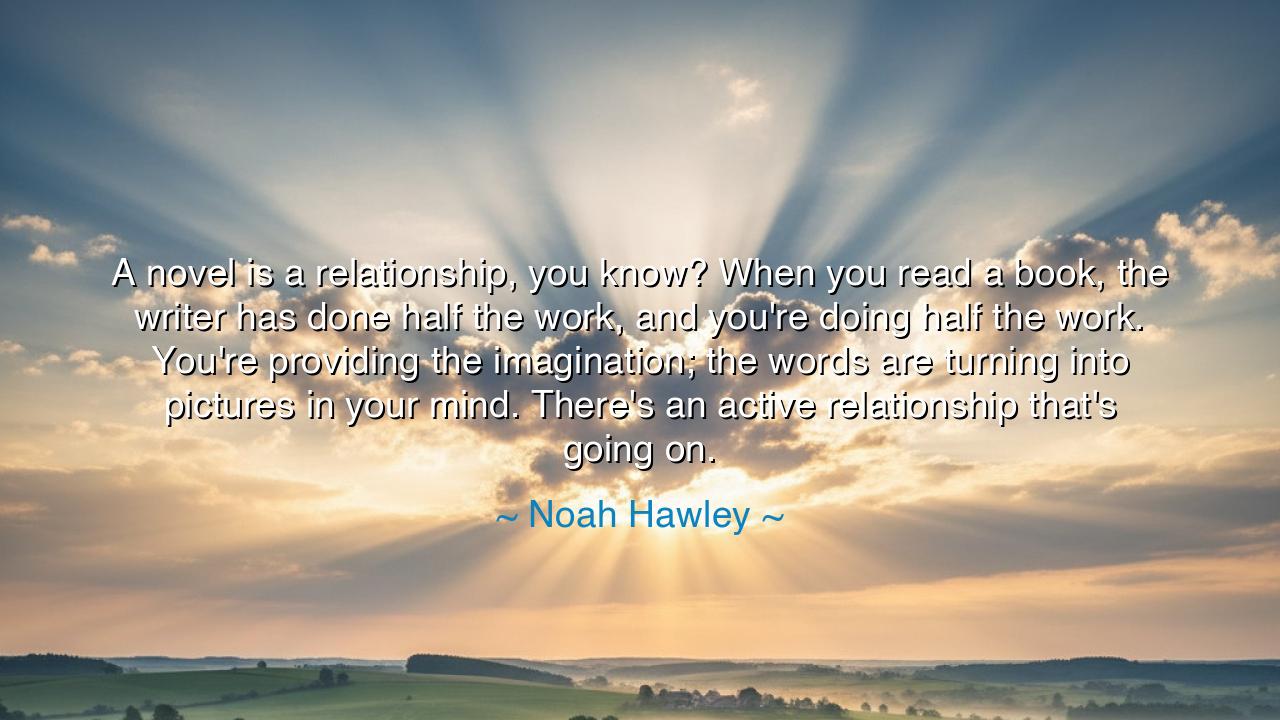
A novel is a relationship, you know? When you read a book, the
A novel is a relationship, you know? When you read a book, the writer has done half the work, and you're doing half the work. You're providing the imagination; the words are turning into pictures in your mind. There's an active relationship that's going on.






The words of Noah Hawley — “A novel is a relationship, you know? When you read a book, the writer has done half the work, and you’re doing half the work. You’re providing the imagination; the words are turning into pictures in your mind. There’s an active relationship that’s going on.” — reveal a truth as ancient as storytelling itself. For in the meeting between the writer and the reader, two souls touch across time and distance. The one offers words like seeds; the other waters them with imagination, and together they make a garden that lives in neither alone. Such is the sacred exchange of art — not domination, but communion.
From the beginning of civilization, stories have not merely been told; they have been shared. The elder spoke beside the fire, and the young listened with open hearts, completing the tale with their own dreams and fears. When Hawley says that a novel is a relationship, he speaks of that eternal bond — the one that joins the voice that creates with the mind that receives. Without the listener, the storyteller is a whisper in the void; without the storyteller, the listener’s imagination lies asleep. Together they awaken, and the world is reborn in words.
Consider the bards of old, who carried the songs of nations within their memories. Homer sang of Achilles and Odysseus, but his power lay not in the words alone; it lived in the hearts of those who heard them and saw, through the veil of verse, the shining shield and the endless sea. Each listener imagined the journey anew, adding to the poet’s song the colors of their own soul. Thus, the Iliad and the Odyssey became not one story, but a thousand — reborn each time a new heart received them. That is the relationship Hawley describes: the endless co-creation between artist and audience.
This sacred exchange continues in every age. When Charlotte Brontë wrote Jane Eyre, she gave the world not a woman, but a flame. Yet that flame burns differently in every reader’s heart. Some see in Jane defiance; others see tenderness. Some find loneliness, others strength. The book does not live in ink, but in the imagination that meets it. It is in this meeting — this collaboration of souls — that literature transcends mortality. The author dies; the story lives on because readers continue to breathe life into it.
The active relationship Hawley speaks of is not limited to books. Every act of creation — painting, music, cinema, even conversation — depends on this same covenant of understanding. The artist’s offering is an open hand; the audience’s imagination is the one that clasps it. And when both hands meet, beauty is born. This is why two people can gaze upon the same story and see two different worlds: because art is not a mirror, but a meeting place.
The ancients understood that reading, like worship or love, requires participation. To read well is to surrender yourself to wonder — to see beyond the black symbols and feel the heartbeat beneath them. When you open a book, you do not merely consume; you contribute. The words awaken visions within you, and you become a silent partner in creation. Thus, to read is not a passive act but a noble labor of the soul, one that cultivates empathy, imagination, and wisdom.
Let this be the lesson: whenever you hold a novel in your hands, remember that it is not a monologue but a conversation. The author has offered half of a world; you must bring the other half. Approach stories not as a consumer, but as a creator. Listen for what is not said. See what cannot be drawn. Feel what no word directly names. For in this sacred collaboration, you do not only read — you become.
And so, as the ancients would teach, the relationship between writer and reader is a reflection of the greater truth: that life itself is a work co-authored by all who live it. The Creator may provide the form, but it is through our imagination, faith, and engagement that the world takes shape. Read deeply, then, and live deeply — for every page, every moment, awaits your touch to make it whole.






AAdministratorAdministrator
Welcome, honored guests. Please leave a comment, we will respond soon